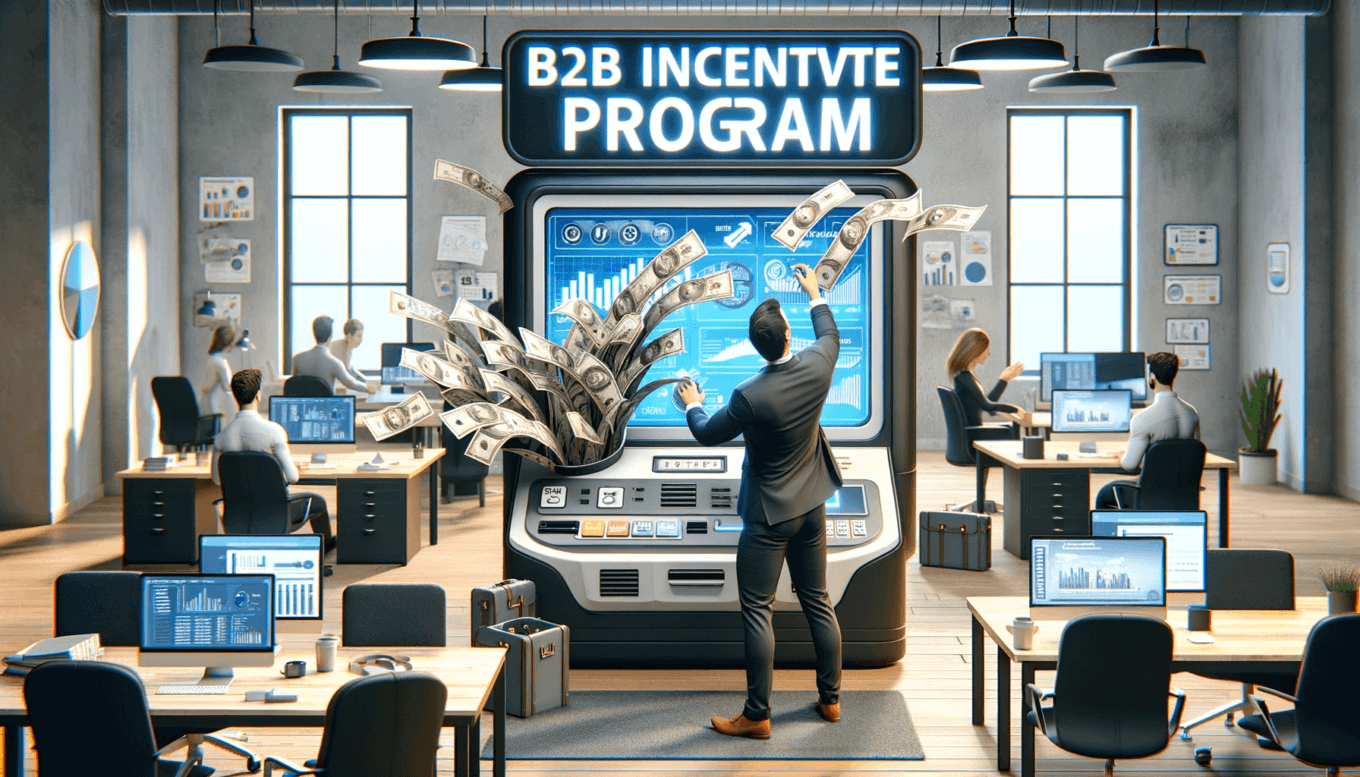Are you looking for ways to boost sales and engage partners? Look no further! In this section, we will explore the top B2B incentive programs and effective strategies to drive performance. B2B incentive programs are an excellent way to incentivize your network and enhance overall sales performance.
So, let’s dive into the world of B2B incentives and discover what it has to offer.

Top B2B Incentive Programs in 2024
| Top B2B Incentive Programs | How They Boost Sales | Implementation Tips for 2024 |
|---|---|---|
| 1. Performance-Based Discounts | Encourages larger orders and repeat business. | Offer tiered discounts based on order size or frequency. |
| 2. Loyalty Programs | Fosters long-term relationships and repeat purchases. | Implement point systems where points can be exchanged for rewards. |
| 3. Volume Rebates | Incentivizes bulk purchases. | Provide rebates for purchases over a certain volume. |
| 4. Co-Branding Opportunities | Leverages brand alignment for mutual benefits. | Offer joint marketing initiatives for high-value partners. |
| 5. Exclusive Access to New Products | Makes partners feel valued with early access. | Give key accounts early access to new products or services. |
| 6. Training and Support Programs | Enhances product knowledge and sales efficacy. | Offer comprehensive training on product usage and benefits. |
| 7. Customized Solutions | Addresses specific customer needs for a tailored fit. | Provide personalized product or service adaptations. |
| 8. Referral Programs | Expands reach through existing customer networks. | Reward clients for successful referrals with discounts or perks. |
| 9. Partner Recognition Programs | Boosts motivation through recognition. | Implement awards or public acknowledgment for top performers. |
| 10. Flexible Payment Terms | Eases financial pressure, encouraging larger orders. | Offer extended or flexible payment terms for reliable partners. |
Implementation Tips for 2024:
- Leverage Technology: Utilize CRM and data analytics tools to tailor programs to specific customer segments.
- Sustainability and CSR: Incorporate sustainability into incentives, aligning with corporate social responsibility values.
- Personalization: Use AI and machine learning to create highly personalized incentive offerings.
- Digital Engagement: Increase the use of digital platforms for program engagement and tracking.
- Agility and Adaptation: Stay flexible and ready to adapt programs as market conditions change.
Understanding B2B Incentive Programs
If you’re interested in boosting sales and engaging partners, understanding B2B incentive programs is essential. Incentive solutions can drive employee motivation and ultimately impact your sales performance.
| Incentive Program | Description | Key Benefit |
|---|---|---|
| Customized Reward Programs | Tailored rewards based on the specific needs and preferences of the business partner. | Enhances partner engagement and loyalty. |
| Performance-Based Discounts | Discounts offered based on meeting or exceeding certain sales or performance targets. | Encourages higher sales volumes. |
| Co-Marketing Opportunities | Joint marketing efforts where both parties contribute resources and share the benefits. | Increases market exposure and brand association. |
| Tiered Loyalty Programs | A system where benefits increase with the level of commitment or business volume from the partner. | Rewards long-term relationships and larger deals. |
| Exclusive Access to Innovations | Early or exclusive access to new products, services, or technologies. | Gives a competitive edge to business partners. |
| Educational and Training Support | Offering training sessions, workshops, or educational materials related to products or industry trends. | Enhances product knowledge and sales skills. |
| Volume Rebates | Rebates provided when purchasing in bulk or exceeding certain volume thresholds. | Incentivizes bulk purchases. |
| Referral Programs | Rewards for referring new clients or businesses. | Expands business network and customer base. |
| Flexible Financing Options | Providing flexible payment terms or financing options for partners. | Eases cash flow for partners, enabling larger purchases. |
| Partner Recognition Programs | Publicly recognizing top-performing partners through awards or acknowledgments. | Motivates and acknowledges partner achievements. |
B2B incentive programs closely resemble their B2C counterparts, but they tend to focus on sales performance incentives as well as employee engagement strategies. With the right incentive solutions, you can keep your employees motivated and engaged with your business goals while boosting sales performance.
Employee motivation programs, which often come in the form of reward and recognition programs, can encourage your team to strive harder and think outside the box when it comes to sales and customer satisfaction.
By setting achievable targets, providing regular performance evaluations, and rewarding outstanding work, you can help your team members feel valued and motivated.
| Incentive Solutions | Employee Motivation Programs |
|---|---|
| Channel Partner Incentives | Reward and Recognition Programs |
| Sales Incentives | Performance-Based Incentives |
When it comes to choosing the right incentive program for your business, it’s important to consider your overall goals first. Do you want to increase sales figures or build long-term relationships with your channel partners?
Are you looking to improve employee engagement, or simply reward top performers?
No matter what your incentive goals may be, understanding the concepts and benefits behind B2B incentive programs is a vital first step
The Role of Sales Incentives in B2B Success
When it comes to B2B success, customer loyalty is key. Sales incentives are a great way to foster customer loyalty and drive business results. By offering rewards and recognition programs, you can motivate your sales team to exceed targets and build lasting relationships with your clients.
Effective sales incentives can come in many forms, such as bonuses, commissions, and other rewards. Consider implementing customer loyalty programs as well, which can encourage continued business and create a sense of partnership between your organization and your clients.
Not sure where to start with sales incentives for your B2B business? Start by analyzing your sales data to identify areas for improvement. Then, work to create incentive programs that are tailored to your unique business needs and goals.
Be sure to communicate the details of your program clearly to your team and customers, and regularly track and measure the impact of your incentive programs.
Sales Incentives Table:
| Sales Incentive Type | Benefits |
|---|---|
| Bonuses | Provide immediate rewards for achieving specific sales targets. |
| Commissions | Encourage sales reps to close deals and drive revenue growth. |
| Customer Loyalty Programs | Build lasting relationships with clients and increase repeat business. |
| Referral Programs | Motivate clients to recommend your business to others. |
By offering a combination of effective sales incentives, you can drive customer loyalty and achieve B2B success. Empower your sales team and build lasting relationships with your clients by implementing tailored incentive programs.
Engaging Channel Partners with Incentive Programs
When it comes to B2B success, your channel partners play a vital role. Building strong and lasting relationships with them is key, and that’s where channel partner incentive programs come in. These programs drive engagement and performance among your channel partners, leading to increased sales and revenue for your business.
One effective strategy is to implement reward and recognition programs that acknowledge exceptional partner performance. By rewarding your partners, you not only increase their motivation but also show them that their efforts are valued. This can lead to increased loyalty and a stronger partnership between your business and your channel partners.
Another powerful incentive program is offering channel partner incentives for meeting performance targets. By setting clear targets and offering incentives for achieving them, you can motivate your partners to work hard and drive sales for your business.
When designing your channel partner incentive programs, it’s important to consider the specific needs of your partners. Investing time in understanding their motivations and goals can help you tailor your incentive programs and ensure their effectiveness.
Table: Types of Channel Partner Incentives
| Type of Incentive | Description |
|---|---|
| Performance-based | Partners receive rewards for reaching specific performance targets |
| Financial incentives | Partners receive direct financial rewards for their performance |
| Non-financial incentives | Partners receive non-monetary rewards such as merchandise, experiences, or recognition |
By implementing effective channel partner incentive programs, your business can build stronger relationships with your partners and drive success in the B2B market.
Performance-Based Incentives for Sales Teams
Want to motivate your sales team to achieve better results? Consider implementing performance-based incentive programs. These programs reward employees based on their sales performance, keeping them motivated to meet and exceed their targets.
Here are a few effective strategies for creating performance-based incentive programs:
1. Set Clear Goals
The first step to creating a successful performance-based incentive program is to set clear, achievable goals. Make sure your team understands what they need to do to earn incentives and how their performance will be tracked. Use data to set sales targets based on past performance and future projections.
2. Offer Attractive Rewards
Reward your sales team with attractive incentives that will keep them motivated to achieve their goals. These incentives can include cash bonuses, gift cards, or even trips or experiences. Consider offering a variety of rewards to appeal to different types of employees.
3. Create Healthy Competition
Encourage healthy competition among your sales team by implementing a leaderboard or other competitive elements. This will motivate your employees to work harder to earn rewards and claim the top spot. Make sure the competition is fair and transparent to avoid any negative effects on team morale.
4. Provide Regular Feedback
Provide regular feedback to your sales team on their performance and progress towards their goals. This will help them stay on track and feel motivated to continue working towards their incentives. Use data and analytics to provide accurate feedback and track employee progress.
By implementing effective performance-based incentive programs, you can drive sales performance, boost team morale, and ultimately achieve better results for your business.
The Power of Customer Loyalty Programs in B2B
When it comes to B2B sales, customer loyalty programs can be a game changer. By incentivizing your customers to stay with your brand, you can increase your sales performance and enhance customer satisfaction.
Implementing a customer loyalty program in your B2B strategy can help you build lasting relationships with your customers. By offering rewards and incentives for repeat business and referrals, you can show your customers that you appreciate their loyalty and value their partnership.
But customer loyalty programs are not one-size-fits-all. When designing your program, consider your target audience and tailor your rewards to their needs and preferences. Whether it’s discounts on future purchases, exclusive access to new products, or personalized experiences, finding the right incentives can mean the difference between a successful loyalty program and one that falls flat.
| Benefits of Customer Loyalty Programs | Examples of Customer Loyalty Rewards |
|---|---|
| Increased sales and revenue | Discounts on future purchases |
| Enhanced customer satisfaction and loyalty | Free products or services |
| Improved customer retention rates | Exclusive access to new products |
| Increased referrals and brand advocacy | Personalized experiences or gifts |
Customer loyalty programs can also help you stand out in a crowded market. By providing unique and valuable rewards, you can differentiate your brand from competitors and create a more loyal customer base.
Overall, implementing a customer loyalty program in your B2B strategy can lead to increased sales performance and enhanced customer satisfaction. By finding the right incentives and tailoring your program to your target audience, you can build lasting relationships with your customers and drive long-term success for your business.
Rewarding and Recognizing Employee Achievements
When it comes to employee engagement strategies, recognition and rewards are essential. Rewarding and recognizing your employees’ achievements can boost their morale, motivation, and overall job satisfaction. A happy employee is a productive employee, and happy employees are more likely to provide excellent customer service and contribute to a positive company culture.
Implementing a reward and recognition program doesn’t have to be complicated or expensive. Simple gestures, such as a handwritten note, public acknowledgement, or an extra day off, can go a long way and make employees feel valued and appreciated.
Consider different types of reward and recognition programs that align with your company’s culture and values. For instance, you could have an employee of the month program where the chosen employee is awarded with a trophy and a gift card. Or, you could implement a peer-to-peer recognition program that encourages employees to nominate their colleagues for outstanding work.
Whatever reward and recognition program you choose, it’s essential to communicate it effectively to your employees, ensuring they understand the criteria and how to earn rewards. Also, track the effectiveness of your program and make adjustments as necessary to keep your employees engaged and motivated.
Examples of Reward and Recognition Programs
| Type of Program | Examples |
|---|---|
| Monetary rewards | Gift cards, bonuses, profit-sharing |
| Non-monetary rewards | Extra time off, flexible schedule, public recognition |
| Employee of the month | Award, trophy, gift card |
| Peer-to-peer recognition | Nomination process, public acknowledgement |
Leveraging Technology for Effective Incentive Solutions
To create a seamless experience for your employees and partners, it’s essential to leverage technology to enhance the effectiveness of your incentive solutions. By using incentive management software, you can automate the process of tracking, managing, and distributing rewards, freeing up valuable time for your team to focus on business-critical objectives.
An incentive management system allows you to set up and customize different programs and use real-time data to evaluate their effectiveness. With the right technology, you can also create a single platform where your employees and partners can access their rewards, making it easy to redeem them and track their progress. Additionally, technology can provide valuable insights into the performance of your incentive programs, allowing you to adjust your approach to maximize results and drive employee motivation.
With a mobile-responsive platform, your employees and partners can access the incentive program from anywhere, making it convenient and accessible to all. The platform can be fully branded, allowing you to create a welcoming and exciting environment that reflects your company and values.
Incorporating technology into your incentive solutions is an effective way to streamline the process, create an optimal user experience, and achieve measurable results. By leveraging technology, you can create a culture of engagement, recognition and drive performance.
Tracking and Measuring Incentive Program Success
Implementing an incentive program is just the first step. To ensure your program is effective, you need to track and measure its success. Here are some key metrics to consider:
- Sales Metrics: Track the number of sales, revenue, and profit over the period your incentive program runs.
- Engagement Metrics: Measure how engaged employees and partners are with your program. This can include participation rates, feedback, and surveys.
- Retention Metrics: Track customer and partner retention rates to determine if your program is driving loyalty and long-term relationships.
- Cost Metrics: Track the cost of your program and compare it to the return on investment (ROI).
There are several tools available to help you analyze the success of your incentive program. Using an incentive solution platform, like Xactly Incent, can streamline the tracking process and provide valuable insights.
Regularly tracking and measuring your incentive program’s success can help you identify areas of improvement and make informed decisions to ensure its ongoing effectiveness.
Best Practices for Implementing B2B Incentive Programs
Implementing B2B incentives can be a complex process that requires careful planning, execution, and management. Here are some best practices and tips to help you successfully implement incentive programs in your organization:
- Define clear goals: Before diving into the specifics of incentive program design, it’s important to define clear goals for what you want to achieve through the program. Are you looking to increase sales, improve employee engagement, or enhance customer loyalty? Make sure the goals are specific, measurable, and achievable.
- Understand your audience: Identify the target audience of your incentive program and personalize it to their specific needs, preferences, and motivations. This will help ensure that the incentive program resonates with them and drives the desired outcomes.
- Choose the right incentives: Research and select incentives that are meaningful, relevant, and desirable to your audience. These can include cash bonuses, gift cards, travel rewards, or other perks.
- Communicate clearly and frequently: Effective communication is key to the success of any incentive program. Keep your audience well-informed about the program’s design, rules, and rewards, and consider using a variety of communication channels to reach them.

- Set achievable targets: Set targets that are challenging but achievable for your audience. This will help them stay motivated and engaged throughout the program.
- Track and measure results: Regularly track and measure the results of your incentive program to assess its effectiveness and identify areas for improvement. Use data analytics tools to gain insights into program performance and make data-driven decisions.
- Continuously improve: Incentive programs are not a one-time event, but an ongoing process. Continuously assess and improve your program to keep it fresh, engaging, and effective.
- Reward positive behaviors: Incentivize positive behaviors that align with your business goals rather than just results. This will help encourage long-term growth and success.
Conclusion
Implementing B2B incentive programs can be a game changer for your business in 2024. By utilizing effective incentive solutions, such as sales incentives and customer loyalty programs, you can drive performance, engagement, and ultimately boost sales.
Remember to track and measure the success of your incentive programs to ensure they are meeting your desired outcomes. Utilize technology to streamline your incentive solutions and create a seamless experience for your employees and partners. And, most importantly, recognize and reward your employee’s achievements to maintain high levels of motivation and engagement.
By following these best practices, you can successfully implement and manage your B2B incentive programs. So, what are you waiting for? Start incentivizing your network and watch your B2B business thrive in 2024!

